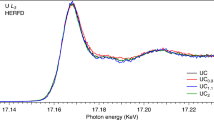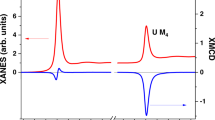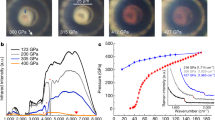Abstract
The free-living, nitrogen-fixing bacterium Azotobacter chroococcum has recently been shown to contain two nitrogenase systems1. One of these is the well-characterized molybdenum-containing enzyme2,3 and the other, which is encoded by different genes, contains vanadium. Both enzyme systems consist of two proteins: an iron protein and a molybdenum- or vanadium-containing protein which also contains iron. The vanadium-containing nitrogenase protein, Ac1*, has a relative molecular mass ~-210,000 and contains 2 vanadium atoms, 23 iron atoms, and 20 acid-labile sulphide ions per mole4. X-ray absorption spectroscopy has been extensively used to probe the environment of molybdenum in the MoFe protein5. The molybdenum is closely associated with iron and sulphur in an iron-molybdenum cofactor, FeMoco, which is probably the N2-binding site of the enzyme6. We report here vanadium X-ray absorption data of the VFe protein, the first such report for any vanadium-containing protein, and compare them with those from a recently synthesized VFeS cluster compound7. The results suggest that the vanadium in this protein is present in a vanadium-containing cofactor analogous to FeMoco. We conclude that substitution of vanadium for molybdenum probably accounts for the different substrate specificities of the two nitrogenases.
This is a preview of subscription content, access via your institution
Access options
Subscribe to this journal
Receive 51 print issues and online access
$199.00 per year
only $3.90 per issue
Buy this article
- Purchase on Springer Link
- Instant access to full article PDF
Prices may be subject to local taxes which are calculated during checkout
Similar content being viewed by others
References
Robson, R. L. et al. Nature 322, 388–390 (1986).
Lowe, D. J., Thorneley, R. N. F. & Smith, B. E. in Metalloproteins, Part 1: Metal Proteins with Redox Roles (ed. Harrison, P. M.) 207–249 (Verlag Chemie, Weinheim, 1985).
Eady, R. R. in Nitrogen Fixation Vol. 4 (eds Broughton, W. J. & Punier, A.) 1–49 (Clarendon, Oxford, 1986).
Eady, R. R., Robson, R. L., Richardson, T. H., Miller, R. W. & Hawkins, M. H. Biochem. J. (submitted).
Newton, W. E. et al. in Nitrogen Fixation Research Progress (eds Evans, H. J., Bottomley, P. J. & Newton, W. E.) 605–610 (Nijhoff, Dordrecht, 1985).
Hawkes, T. R., McLean, P. A. & Smith, B. E. Biochem. J. 217, 317–321 (1984).
Kovacs, J. A. & Holm, R. H. J. Am. chem. Soc. 108, 340–341 (1986).
Van der Hoek, M. J. et al. Nucl. Instrum. Meth. A246, 380 (1986).
Lee, P. A. & Pendry, J. B. Phys. Rev. B 11, 2795–2811 (1975).
Perutz, M. F., Hasnain, S. S., Duke, P. J., Sessler, J. L. & Hahn, J. E. Nature 295, 535–538 (1982).
Gurman, S. J., Binsted, N. & Ross, I. J. Phys. 17, 143–151 (1984).
Wong, J., Lytle, F. W., Messmer, R. P. & Maylotte, D. H. Phys. Rev. B30, 5596–5610 (1984).
Author information
Authors and Affiliations
Rights and permissions
About this article
Cite this article
Arber, J., Dobson, B., Eady, R. et al. Vanadium K-edge X-ray absorption spectrum of the VFe protein of the vanadium nitrogenase of Azotobacter chroococcum. Nature 325, 372–374 (1987). https://doi.org/10.1038/325372a0
Received:
Accepted:
Issue Date:
DOI: https://doi.org/10.1038/325372a0
This article is cited by
-
Experimental and theoretical correlations between vanadium K-edge X-ray absorption and K \(\varvec{\beta} \) β emission spectra
JBIC Journal of Biological Inorganic Chemistry (2016)
-
The discovery of Mo(III) in FeMoco: reuniting enzyme and model chemistry
JBIC Journal of Biological Inorganic Chemistry (2015)
-
Nitrogenase and homologs
JBIC Journal of Biological Inorganic Chemistry (2015)
-
The nifU, nifS and nifV gene products are required for activity of all three nitrogenases of Azotobacter vinelandii
Molecular and General Genetics MGG (1992)
Comments
By submitting a comment you agree to abide by our Terms and Community Guidelines. If you find something abusive or that does not comply with our terms or guidelines please flag it as inappropriate.



